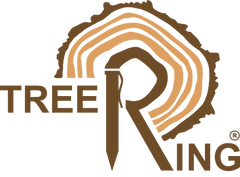THE LAST PHOTO OF DAVE WAGER- FOUNDER OF TREE RING PENS
Like the abrupt mountains rising from the plains, arrival of summer in Montana was not subtle. Afternoon temperatures were in the 90′s, and both the land and I were thirsty. I was wandering the mountains above the Blackfoot River looking for remnant patches of old growth ponderosa pine and larch trees. Most of Montana’s forests are second growth, but remnant pockets of virgin old growth forests remain. These trees often occur on terrain that was too difficult to log when the forests were first harvested early in the 20th century. Excited and distracted by the search, I wandered off the trail long enough to become lost. I had been lost for a couple hours when I discovered what I had been looking for. It was a small stand of old growth pine trees, and a good candidate for restoration work. Underneath the majestic 300 year old towering pine trees rose a carpet of small diameter Douglas-fir trees that stressed the ancient trees above. The excitement of the discovery distracted me from my lost state.

I stood next to an ancient ponderosa pine that had towered over this landscape for hundreds of years. I pictured this tree standing tall as the Declaration of Independence was signed in 1776 and as Lewis and Clark explored uncharted waters below in 1806. I thought of the concentric rings of this tree telling hundreds of stories of droughts, fires, and floods. The small trees underneath were about 100 years old and had their own stories to tell. But I wanted to be telling a story about their end, or at least their transformation into something new, because removing these unnaturally dense trees helps protect the adjacent old growth trees from stress-related mortality and catastrophic fire.
Looking around, my gaze focused on a camouflaged plastic box strapped to a tree. I examined it closely, not having seen anything like it before. With eyes right up into it, I then realized it was a motion triggered camera for photographing wildlife. The camera clicked, and I was captured for posterity. The snapshot reminded me that I was lost and nearing dehydration. I resented being captured on film. I thought in the event that I didn’t make it out, this would be my last photo. Given my ragged look, it would be an unflattering way to be remembered.
I eventually found my way out, relieved that although my face might end up in a wildlife researcher’s portfolio it wouldn’t be my last photo. By now you might be wondering what I was trying to accomplish that afternoon in the mountains of Montana. I was driven by the passions to share tree ring history and restore old growth forests. After studying dendrochonology (tree ring science), I wanted to find a way to share the wonder of tree rings and their imbedded history. I looked for a commonly used wood medium – and discovered that turning the wood into pens that display the tree rings was the perfect form. When I learned that trees with some of the oldest stories are being prematurely lost to overly dense forest conditions, I thought about what could be done. The solution is easy in theory: simply harvest the competing trees and release the older overstory trees.

However, removing the wood from the isolated small patches of forest is expensive. Like a vein of gold embedded deep within rock, there is a high cost to removing trees from steep and remote terrain. The value of the wood in its typical end use (lumber, paper, or cardboard) is far less than the cost to harvest the trees. The economic solutions include lessening the cost of harvesting, subsidizing the restoration, and/or raising the value of the restoration product. Focusing on the second and third solutions, the Tree Ring Pen and its brand of rustic elegance was formed, transforming the value of this wood from commodity to keepsake. It is a brand born from two compelling stories: celebrating history through the growth rings of century old trees and restoring old growth forests. These high quality writing instruments with unique stories garner a premium that allows for and helps subsidize restoration forestry. To learn more about tree rings, pens, and forest restoration take a tour through www.TreeRingPens.com. Order a pen and you can hold the tree rings and the forest restoration in your hand.


Leave a comment